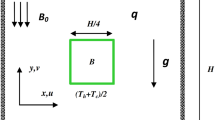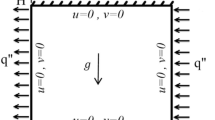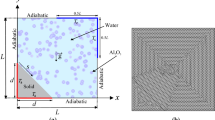Abstract
This work presents some comments concerning the paper entitled ‘Lattice Boltzmann simulation of alumina-water nanofluid in a square cavity’ by Yurong He, Cong Qi, Yanwei Hu, Bin Qin, Fengchen Li and Yulong Ding which was published in Nanoscale Research Letters in 2011. The comments are related to the numerical parameters and the computed results of average Nusselt number.
Similar content being viewed by others
Background
The authors of ‘Lattice Boltzmann simulation of alumina-water nanofluid in a square cavity’ [1] have used the conventional lattice Boltzmann scheme to analyse the heat transfer and flow characteristics of Al2O3-water nanofluid in a square cavity. They described the numerical methodology which implemented the double-population lattice Boltzmann scheme to predict both flow and thermal fields. In this paper, few comments on the numerical parameters and the computed results will be highlighted, followed by a conclusion and list of references.
Numerical parameter
The authors have carried out a grid independence test using three grid sizes of 1922, 2562 and 3002 to predict the average Nusselt number at Ra = 8 × 105 and 0% of volume fraction (page 5 of 8). The authors have chosen the 2562 grid size and claimed that this grid size gave a grid-independent solution. Since 0% of the volume fraction has been chosen, the condition can be referred as natural convection of pure water in an enclosure [2–5]. However, the rest of the predictions involved a more critical condition, such as the Rayleigh number being greater than 106 with a 5% of volume fraction of Al2O3. Thus, it is extremely difficult to rely on the grid size that resulted from the grid independence test at such mild condition. In addition, the obtained average Nusselt number at a grid size of 2562 deviates about 4.5% from the benchmark results. Therefore, it can be concluded that this grid size is not suitable and can lead to wrong results as will be discussed in the ‘Numerical results’ section.
Numerical results
The authors have stated that as the volume fraction is increased, the fluid becomes more viscous and the velocity of the flow in the enclosure decreases (page 7 of 8). At this point, the authors ignored the fact that the presence of nanoparticles stimulates the flow that resulted from high-energy transport through the flow associated with the irregular motion of nanoparticles [6–8]. This behaviour leads the thermal boundary layer to become thinner and the Nusselt number to increase [9]. Even though the authors have claimed that the Nusselt number decreases as the volume fraction increases, which was demonstrated in figure six of the said article, their results however are still questionable since they have been computed using inappropriate grid sizes.
Discussion
The present commentary aimed at providing an in-depth discussion on the numerical methodology described in the work of He et al. [1]. The contribution of the present work is in correcting a number of mistakes made in an attempt to predict the heat and flow characteristics of nanofluids in enclosure.
Conclusion
We recommend that the authors perform code validation by comparing with the well-known benchmark solution. We also suggest that the authors conduct a grid independence test on the most critical condition of their research case in order to comprehend the effect of grid size on the numerical solution.
References
He Y, Qi C, Hu Y, Qin B, Li F, Ding Y: Lattice Boltzmann simulation of alumina-water nanofluid in a square cavity. Nanoscale Res Lett 2011, 6: 184–191. 10.1186/1556-276X-6-184
Munir FA, Nor Azwadi NAC, Ibrahim NIN: Numerical simulation of natural convection in inclined square cavity. J Appl Sci 2011, 11: 373–378.
Fakhreddine SO, Rachid B: Heterogeneous nanofluids: natural convection heat transfer enhancement. Nanoscale Res Lett 2011, 6: 222–232. 10.1186/1556-276X-6-222
Nor Azwadi NAC, Idris MS: Finite different and lattice Boltzmann modelling for simulation of natural convection in a square cavity. Intl J Mech Mat Eng 2010, 5: 80–86.
Peng Y, Shu C, Chew YT: Simplified thermal lattice Boltzmann model for incompressible thermal flows. Phys Rev E 2003, 68: 026701/1–026701/8.
Veeranna S, Lakshmi NS: AL2O3-base naofluids: a review. Nanoscale Res Lett 2011, 6: 456–471. 10.1186/1556-276X-6-456
Mahmoodi M, Hashemi SM: Numerical study of natural convection of a nanofluid in C-shaped enclosures. Intl J Thermal Sci 2012, 55: 76–89.
Saeed ZH, Seyyed HN, Elham T, Javad S: Numerical investigation of Al2O3/water nanofluid laminar convective heat transfer through triangular ducts. Nanoscale Res Lett 2011, 6: 179–188. 10.1186/1556-276X-6-179
Peter V: Heat transfer augmentation in nanofluids via nanofins. Nanoscale Res Lett 2011, 6: 154–166. 10.1186/1556-276X-6-154
Acknowledgments
This research is financially supported by the Ministry of Higher Education of Malaysia through Fundamental Research Grant Scheme, FRGS Vot no. 4F114.
Author information
Authors and Affiliations
Corresponding author
Additional information
Competing interests
The authors declare that they have no competing interests.
Authors’ contributions
AS conceived the study and checked the grammar of the manuscript. NACS drafted the manuscript. Both authors read and approved the final manuscript.
Rights and permissions
Open Access This article is distributed under the terms of the Creative Commons Attribution 2.0 International License (https://creativecommons.org/licenses/by/2.0), which permits unrestricted use, distribution, and reproduction in any medium, provided the original work is properly cited.
About this article
Cite this article
Sidik, N.A.C., Safdari, A. Comments on ‘Lattice Boltzmann simulation of alumina-water nanofluid in a square cavity’ by Yurong He, Cong Qi, Yanwei Hu, Bin Qin, Fengchen Li and Yulong Ding. Nanoscale Res Lett 7, 648 (2012). https://doi.org/10.1186/1556-276X-7-648
Received:
Accepted:
Published:
DOI: https://doi.org/10.1186/1556-276X-7-648




